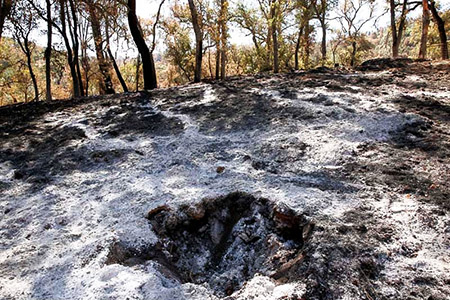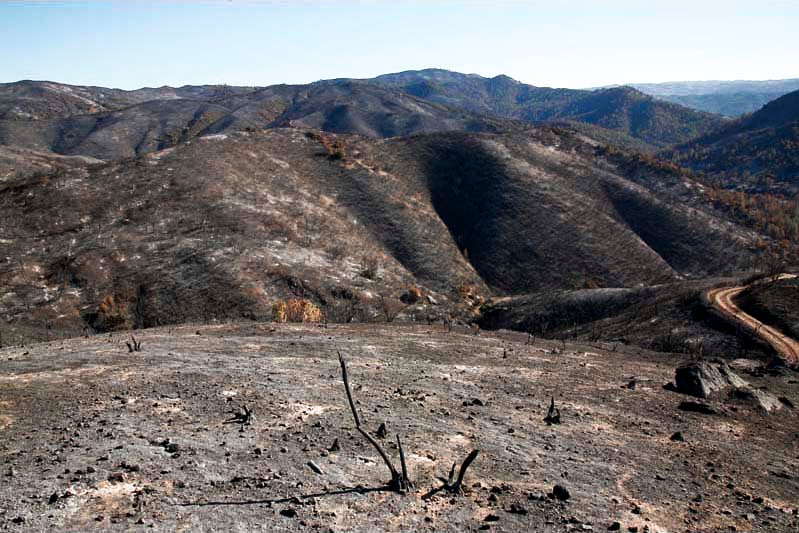The "Lick Incident" that burned 47,760 acres, most of it within the 87,000 acres that comprise Henry W. Coe State Park, broke out on September 3, 2007 and was fully contained on September 11.
Fire is one of the major physical factors that shapes plant communities. The seeds of some species require a heat shock before they will germinate. The seeds of others require chemicals contained in smoke to germinate. Fire clears the woody debris of the forest floor to ash and returns essential minerals to depleted soils.

Ash returns essential minerals to depleted soils
Fire has been a part of the inner coast range environment since long before the arrival of man and continues to be an essential factor. Many of you may have been concerned that the fire had severely damaged the park. In fact, it will certainly prove to be a beneficial event. In large areas of open blue oak woodland the fire remained on the ground and scarcely touched the trees. Even when the oak leaves were badly singed, there is the expectation that most of the trees will recover.

Fire remained on the ground, scarcely touching these blue oaks
As with most wildfires, this one was a mosaic. There are many lightly burned and completely unburned areas that served as refuges for larger animals and will serve as a source for seeding in some of the more severely burned areas.

The fire burned in a mosaic pattern
Some areas did indeed burn fiercely: especially those in which highly flammable chamise had built up to dangerous levels. In some areas the skeletons of the chaparral shrubs remain standing, but in others the fire was so hot that there is essentially nothing left. Fortunately, these "moonscapes" are the exception rather than the rule. Where the skeletons stand, it will not be long after the first rains that new sprouts appear at their bases. Obviously regeneration of vegetation in the most severely burned areas will take some time. However, the longer the chamise chaparral is allowed to grow without fire the more dangerous it becomes. It will be many years before it builds up to such hazardous levels again.

A "moonscape" near Bear Mountain Road
The recovery process has already started. Although the meadows were essentially black right after the fire many are a light tan color as seen from a distance. Close inspection reveals hundreds of small fresh dirt mounds, indicating that large numbers of gophers have survived and are perhaps busy feasting on toasted grass roots.

Gophers turn the fire blackened meadows tan
Many of the oaks with impacted crowns shed huge numbers of acorns and it hasn't taken the deer long to find them. Just two weeks after the fire small bits of green have appeared even in some fairly heavily impacted areas. Fresh elk and coyote droppings can already be found in areas that were still smoking a few weeks ago.

Many oaks shed huge numbers of acorns
We have a unique opportunity to monitor the recovery process in Coe Park's many different plant communities. We also have wonderful opportunity to develop materials for public education and if the study warrants, one or more scientific publications. Following this regeneration will be fascinating and is bound to turn up some surprises.

Fresh elk droppings in a recently burned meadow along Orestimba Creek
---
Dr. Winslow R. Briggs, Director Emeritus at Carnegie Institution of Washington's Department of Plant Biology, has been a Coe Park Volunteer for more than 30 years
---
Bob Patrie, who has been a volunteer at H.W. Coe State Park since 1971, created and maintains this website
 Last updated - 04/07/2012 lick fire coe park fire coe fire 2007 bob patrie ron fischler panoramas fire recovery pine ridge association wildfire recovery henry w. coe state park
Last updated - 04/07/2012 lick fire coe park fire coe fire 2007 bob patrie ron fischler panoramas fire recovery pine ridge association wildfire recovery henry w. coe state park








